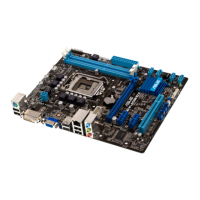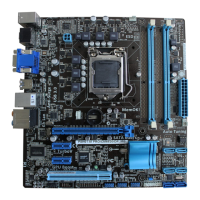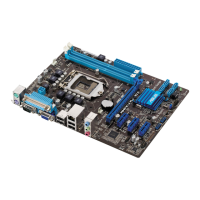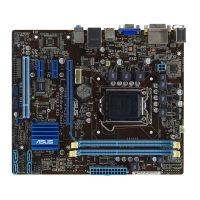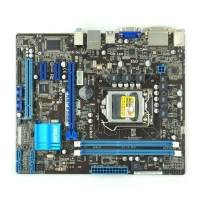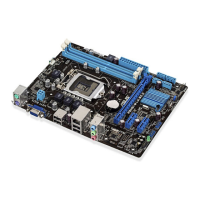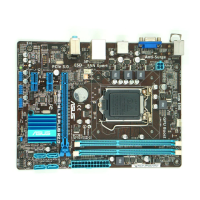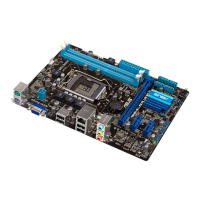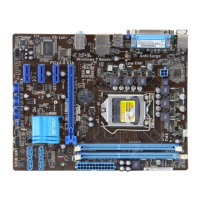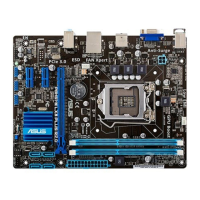Do you have a question about the Asus P8H61-M EVO and is the answer not in the manual?
FCC compliance statement regarding radio frequency interference and operation.
Canadian compliance statement for radio noise emissions from digital apparatus.
Information on ASUS product, battery, and packaging recycling programs.
Precautions for safe electrical handling, installation, and environmental conditions.
Explains manual organization, symbols, and text formatting for clarity.
Directs users to ASUS websites and optional documentation for further details.
Details CPU socket, supported processors, Intel H61 chipset, and DDR3 memory support.
Outlines graphics outputs, SATA ports, LAN, USB, and expansion slot specifications.
Introduces the motherboard and lists essential package items for verification.
Highlights the motherboard's support for Intel processors and integrated controllers for performance.
Details chipset, memory, USB 3.0, SATA 6Gb/s, PCIe 2.0, and audio/LAN features.
Covers EFI BIOS, MemOK!, TurboV, and GPU Boost for system management and performance.
Explains Anti-Surge Protection and EPU for system safety and energy efficiency.
Instructions on correct motherboard orientation and securing it in the chassis.
Identifies key connectors, jumpers, and slots on the motherboard with page references.
Step-by-step guide for installing the CPU, heatsink, and fan assembly.
Procedure for safely uninstalling the CPU heatsink and fan assembly.
Describes DDR3 DIMM sockets and recommended memory installation configurations.
Details memory types, limitations, QVL, and steps for installing/removing DIMMs.
Guides for installing expansion cards and configuring them via BIOS settings.
Explains the functionality of PCI Express x1 and x16 slots.
Instructions for using the CLRTC jumper to reset CMOS settings and system passwords.
Identifies all ports on the motherboard's rear I/O panel, including audio, video, and networking.
Details audio configuration ports, video output ports, and USB ports on the rear I/O.
Explains connections for chassis front panel audio and Trusted Platform Module (TPM).
Details ASMedia and Intel SATA connectors, and the serial port connector.
Covers CPU/Chassis fan connectors, ATX power supply interfaces, and internal USB headers.
Describes system panel connectors for LEDs/buttons and the digital audio SPDIF connector.
Explains the MemOK! switch for automatic memory compatibility testing and tuning.
Describes the GPU Boost switch function and the purpose of onboard LEDs like Standby Power.
Guides on installing Windows OS and utilizing the motherboard support DVD.
Covers BIOS management, backup, and update procedures using ASUS utilities.
Explains how to enter the BIOS setup and navigate between EZ Mode and Advanced Mode.
Allows setting BIOS language, date, time, and configuring system security passwords.
Settings related to CPU ratio, thermal monitor, processor cores, and virtualization.
Configuration for northbridge, SATA modes, USB legacy support, and onboard devices.
Advanced Power Management settings and serial/parallel port configurations.
Displays system temperatures, voltages, and fan speeds for hardware monitoring.
Options for CPU and Chassis Q-Fan control, fan profiles, and speed limits.
Configures boot sequence, NumLock state, boot device priorities, and error handling.
Access to utilities like EZ Flash 2 for BIOS updates, SPD information, and OC profiles.
Options to load default settings, save or discard changes, and exit the BIOS setup program.
FCC compliance statement regarding radio frequency interference and operation.
Canadian compliance statement for radio noise emissions from digital apparatus.
Information on ASUS product, battery, and packaging recycling programs.
Precautions for safe electrical handling, installation, and environmental conditions.
Explains manual organization, symbols, and text formatting for clarity.
Directs users to ASUS websites and optional documentation for further details.
Details CPU socket, supported processors, Intel H61 chipset, and DDR3 memory support.
Outlines graphics outputs, SATA ports, LAN, USB, and expansion slot specifications.
Introduces the motherboard and lists essential package items for verification.
Highlights the motherboard's support for Intel processors and integrated controllers for performance.
Details chipset, memory, USB 3.0, SATA 6Gb/s, PCIe 2.0, and audio/LAN features.
Covers EFI BIOS, MemOK!, TurboV, and GPU Boost for system management and performance.
Explains Anti-Surge Protection and EPU for system safety and energy efficiency.
Instructions on correct motherboard orientation and securing it in the chassis.
Identifies key connectors, jumpers, and slots on the motherboard with page references.
Step-by-step guide for installing the CPU, heatsink, and fan assembly.
Procedure for safely uninstalling the CPU heatsink and fan assembly.
Describes DDR3 DIMM sockets and recommended memory installation configurations.
Details memory types, limitations, QVL, and steps for installing/removing DIMMs.
Guides for installing expansion cards and configuring them via BIOS settings.
Explains the functionality of PCI Express x1 and x16 slots.
Instructions for using the CLRTC jumper to reset CMOS settings and system passwords.
Identifies all ports on the motherboard's rear I/O panel, including audio, video, and networking.
Details audio configuration ports, video output ports, and USB ports on the rear I/O.
Explains connections for chassis front panel audio and Trusted Platform Module (TPM).
Details ASMedia and Intel SATA connectors, and the serial port connector.
Covers CPU/Chassis fan connectors, ATX power supply interfaces, and internal USB headers.
Describes system panel connectors for LEDs/buttons and the digital audio SPDIF connector.
Explains the MemOK! switch for automatic memory compatibility testing and tuning.
Describes the GPU Boost switch function and the purpose of onboard LEDs like Standby Power.
Guides on installing Windows OS and utilizing the motherboard support DVD.
Covers BIOS management, backup, and update procedures using ASUS utilities.
Explains how to enter the BIOS setup and navigate between EZ Mode and Advanced Mode.
Allows setting BIOS language, date, time, and configuring system security passwords.
Settings related to CPU ratio, thermal monitor, processor cores, and virtualization.
Configuration for northbridge, SATA modes, USB legacy support, and onboard devices.
Advanced Power Management settings and serial/parallel port configurations.
Displays system temperatures, voltages, and fan speeds for hardware monitoring.
Options for CPU and Chassis Q-Fan control, fan profiles, and speed limits.
Configures boot sequence, NumLock state, boot device priorities, and error handling.
Access to utilities like EZ Flash 2 for BIOS updates, SPD information, and OC profiles.
Options to load default settings, save or discard changes, and exit the BIOS setup program.
| Non-ECC | Yes |
|---|---|
| Memory channels | Dual-channel |
| Number of memory slots | 4 |
| Maximum internal memory | 16 GB |
| Supported memory clock speeds | 1066, 1333 MHz |
| Processor socket | LGA 1155 (Socket H2) |
| Processor manufacturer | Intel |
| Compatible processor series | Intel Core i3, Intel Core i5, Intel Core i7 |
| Maximum number of SMP processors | 1 |
| USB 2.0 connectors | 3 |
| Number of Parallel ATA connectors | - |
| Headphone outputs | 5 |
| USB 2.0 ports quantity | USB 2.0 ports have a data transmission speed of 480 Mbps, and are backwards compatible with USB 1.1 ports. You can connect all kinds of peripheral devices to them. |
| Firewire (IEEE 1394) ports | 0 |
| Audio chip | Realtek ALC887 |
| Component for | PC |
| Power source type | ATX |
| Motherboard chipset | Intel® H61 |
| Audio output channels | 7.1 channels |
| Motherboard form factor | micro ATX |
| Parallel processing technology support | Not supported |
| Trial software | Antivirus |
| Bundled software | ASUS utilities ASUS Update |
| LAN controller | Realtek RTL8111E |
| Ethernet interface type | Gigabit Ethernet |
| BIOS type | AMI |
| ACPI version | 2.0a |
| BIOS memory size | 32 Mbit |
| Width | 244 mm |
|---|
